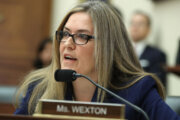My Two Cents is a weekly opinion column from Bethesda resident Joseph Hawkins. The views and opinions expressed in this column are those of the author and do not necessarily reflect the views of BethesdaNow.com.
I live in Bethesda. I work in Rockville. I frequently find myself on Rockville Pike — Maryland State Highway Route 355.
Last Friday, while waiting for a car repair, I had the bright idea of crossing the Pike on foot from Fitzgerald’s Auto Mall to the Whole Foods store on Woodglen Drive to pick up something extra for dinner.
Crossing the Pike on foot is not a bright idea. Nonetheless, I made it across and back without getting killed.
Without getting killed?
Honestly, does any other thought run through your mind when walking the Pike near White Flint? Well, that famous scene from “Forest Grump” ran through my head as I stood in front of Fitzgerald’s deciding whether to cross: “Run Forrest, run!”
 I’m fascinated by the dreams being cooked up to make the Pike and the White Flint area a more walkable community. Just last week, Lindsay Hoffman, executive director of the Friends of White Flint, penned the following about White Flint area:
I’m fascinated by the dreams being cooked up to make the Pike and the White Flint area a more walkable community. Just last week, Lindsay Hoffman, executive director of the Friends of White Flint, penned the following about White Flint area:
“This “place” — close to a third of which was surface parking lots — will become a denser, more walkable community, the scope of which has never been seen in Montgomery County.”
I’m mostly fascinated because the Pike I sprinted across last week, and frequently traverse, is an absolute mess. In front of Fitzgerald’s, cars zoom along at speeds of 45 miles per hour or higher.
“Run Forrest, run!”
I see Hoffman’s vision for White Flint in my head. Yet, I’m still puzzled by the absolute reality that the Pike is a major Maryland commuter artery. And the Pike’s volume of traffic seems rather huge to me. And so, who the heck is responsible for making all (or many) of the cars disappear? And don’t many of the cars have to disappear to achieve that walkable community of our dreams?
We could just run a tunnel between the Beltway and Montrose Parkway. Force the traffic underground. (Is there an extra $5 billion just hanging around for such a pipedream? Nope.)
I’m no urban planner or traffic engineer, but as a county resident, I have been involved with the State Highway Administration in an efforts to make a simple state highway more walkable. It was no walk in the park.
I live on Wilson Lane, State Highway Route 188. It’s one of the shortest state highways, running approximately three miles between MacArthur Boulevard and Old Georgetown Road. I’ve lived on Wilson since 1984.
Shortly, after moving in, a group of neighbors formed the Wilson Lane Safety Coalition. I joined the Coalition. Our goals were modest: Lower speed limits, eliminate pass lanes, remove from the state plans all recommendations to add traffic lanes and get the state to build a continuous sidewalk connecting MacArthur Boulevard to Old Georgetown Road.
We achieved these goals, and after doing so the Coalition folded.
Over seven years, the Coalition met with State Highway administrators multiple times. Meetings were always friendly. However, regardless of the specific topic of the meeting, I recalled one overarching theme from the state folks. It always was their number one talking point and priority: Wilson Lane is a secondary commuter artery and its mission is to move vehicle traffic into and out of downtown Bethesda.
So while residents along Wilson viewed Wilson one way — friendly “country lane” and walkable — State Highway administrators viewed Wilson entirely differently — highway serving a useful commuter mission. Their primary goal was to keep the cars moving.
Today, Wilson is friendlier to pedestrians than it was when I moved into the neighborhood 30 years ago. Slowing cars down and adding sidewalks made a huge difference. And the permanent presence of speed cameras helps — it definitely alters driving behaviors.
And yet, in my opinion, the state folks’ view of Wilson Lane never altered. Wilson still serves as a secondary commuter artery. The car traffic never disappeared.
Right now, White Flint dreamers are poking around the edges, baby-stepping to solutions to make the Pike more pedestrian friendly — that walkable heaven. Baby steps are good. But some of the White Flint artist renderings I’ve seen have most car traffic missing.
It’s like abracadabra — no cars! Walker’s heaven.
I love the vision. But my Wilson Lane lessons tell me that a vision with fewer cars — or policies that prevent cars from doing what cars do is not one that is shared by State Highway folks. Those folks have one mission in life: Keep the vehicle traffic moving.
And so without that tunnel under the Pike or some way to displace the existing Pike traffic, what aspects of the White Flint vision get compromised?
In the meantime, it’s probably 20 more years of Run Forrest, run!
Rendering via White Flint Partnership
Joseph Hawkins is a longtime Bethesda resident who remembers when there was no Capital Crescent Trail. He works full-time for an employee-owned social science research firm located Montgomery County. He is a D.C. native and for nearly 10 years, he wrote a regular column for the Montgomery Journal. He also has essays and editorials published in Education Week, the Washington Post, and Teaching Tolerance Magazine. He is a serious live music fan and is committed to checking out some live act at least once a month.








